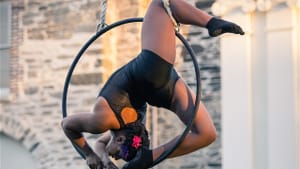Stay in the Loop
BSR publishes on a weekly schedule, with an email newsletter every Wednesday and Thursday morning. There’s no paywall, and subscribing is always free.
The limbo of life
Philly Fringe 2020: Tangle Movement Arts presents ‘The Way Out’

We pulled the car into Laurel Hill Cemetery, put on our masks, and rolled down the window to be greeted by Sue, box office manager for The Way Out from Tangle Movement Arts. “This is our first rolling show!” she said before explaining how to proceed through this immersive, site-specific, drive-in Fringe Festival performance with multiple stations throughout the grounds. It was my first rolling show as well, and The Way Out was a marvel of pandemic innovation as well as thoughtful execution.
Each $100 ticket covered one car, drive-in movie style. But this was live performance, and unlike a drive-in screen, it wasn’t one show that everyone watched together. Instead, ticket holders drove to six different stations at which artists performed short works in different mediums just for those in your car. This clever idea was made all the more enjoyable by careful planning, which included directional signs, ushers with illuminated traffic wands (the performance took place at night), clear verbal instructions from the ushers, and information and a program emailed in advance.
Glass, grass, and graves
At Station 1, Christina Eltvedt performed her work Unraveled / Woven with Elizabeth June
Bergman and Ashley Rivera. The three dancers made a moving tableau using a chair, a stool, and a ladder. Each held a hoop with streamers that they used to make shapes as the lights cast shadows in the trees and on nearby gravestones. Station 2 featured Madeline Rile Smith, who combined glass artistry with performance in Captured / Shattered. An audio recording about alchemy transformed Smith’s glass-blowing demonstration into a spooky and thought-provoking experience.
Dancers Evalina Carbonell and Weiwei Ma performed Contained / Flowing at Station 3, in front of the Allen crypt. Whirling arms depicted flowing movements, and I saw containment as the dancers lay on their backs in the grass, twitching hands and feet in the air like overturned insects. Station 3 was performed on the driver’s side, which meant I had an obstructed view from the passenger’s seat. But The Way Out thoughtfully alternated sides and perspectives, favoring none, and most stations were on a slope or an elevation to improve the view from the car.
Pandemic time
At the next stop, Ama Ma’at Gora, Felisha George, Sophiann Moore, Surya Swilley, and November Ward performed Gora’s dance Liberation / Rest. Addressing police violence and racism, it used evocative video footage of Assata Shakur—a former Black Panther and Black Liberation Army member—to raise questions about the speed of progress. The most creative use of space in The Way Out, this piece projected video onto a crypt behind the dancers, who moved inside a large, sunken grave.
Station 5 featured the multidisciplinary artist Eppchez!, who combined vocal looping with live singing in a musical performance about the world we live in now. The most comprehensively topical piece in The Way Out, it had lyrics referencing days that “aren’t shaped like days” and the dignity, food, and safe housing we all deserve. Eppchez!’s impressive vocal range mirrored the elliptical quality of both the loops as well as time itself during quarantine.
Forces of will
The final station was the most impressive, a two-part aerial work done on a portable rig. Kate Aid, Lesley Berkowitz-Zak, Rebecca MoDavis, Najwa Parkins, and Deena Weisberg took turns on the silks, performing to voiceovers by Lauren Rile Smith and Pascale Smith. These referenced items and themes familiar to life in 2020, including hand sanitizer, grief, and isolation. The artists suspended in the air by their muscles and force of will evoked the limbo we’re all in and the strength we need to persevere. Meanwhile, The Way Out’s multiple stops on a journey through a cemetery setting offered a physical reminder of the final destination of every life as well as the healing power of time.
Image description: A woman aerial artist in a black leotard poses gracefully upside down, her back arched inside a suspended black hoop, one leg raised with a knee hooked on the rope holding the hoop.
What, When, Where
The Way Out. By Tangle Movement Arts. October 1 through 3, 2020, part of the Philadelphia Fringe Festival. Performed at Laurel Hill Cemetery, 3822 Ridge Avenue, Philadelphia. More info here.
Sign up for our newsletter
All of the week's new articles, all in one place. Sign up for the free weekly BSR newsletters, and don't miss a conversation.

 Melissa Strong
Melissa Strong